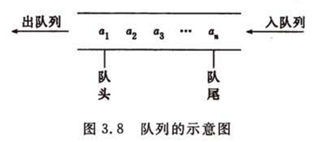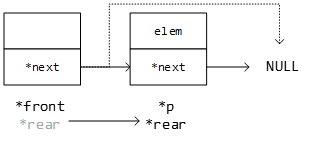————————————————————————————————————————————
基本概念:
- 和栈相反,队列是一种先进先出(FIFO)的线性表。只允许在一端插入,在另一端删除。
-
允许插入的叫"队尾"(rear),允许删除的叫"队头"(front)。

- 使用场景:操作系统的作业排队。在允许多道程序运行的计算机系统中,同时有几个作业运行。如果运行结果都需要通道输出,则按照请求输出的先后次序排队。每当通道传输完毕可以接受新的输出任务时,队头的作业先从队列中退出作输出操作。申请输出的作业都从队尾进入。
- - - - - - - - - - - - - - - - - - - - - - - - - - - - - - - - - - - - - - - - - - - - - - - - - - - - - - - - - - - - - - - - - - - - - - - - - -
基本操作:
/* 定义链表队列 */
struct Node //结构体存放节点

struct LinkQueue //存放队头指针和队尾指针,不存放在Node中是为了节省节点入队时占用的内存空间

/* 初始化队列 */
队头指针和队尾指针共同申请一个内存空间
节点下一节指向NULL
注意:头结点的数据为空

/* 入队操作 */
申请新节点
输入的数据elem存放在新节点数据中
新节点下一节指向NULL
尾节点的下一节点指向新节点
队尾指针指向新节点

/* 出队操作 */
节点指针p指向队头结点
队头结点指向第一节点
释放指针p指向的节点
p指向NULL //避免野指针

/* 打印操作 */
由于头节点为空,所以从第二节点开始打印,直到指向NULL时停止打印

实现代码:
1 #include <stdio.h> 2 #include <stdlib.h> 3 #define OK 1 4 #define ERROE 0 5 #define OVERFLOW -2 6 typedef int Status; 7 typedef int QElemType; 8 typedef struct Node 9 { 10 QElemType data; 11 struct Node *next; 12 } QNode; 13 /* 当链式队列的头尾节点指针定义成为一个单独的结构体,避免在新增节点时占用过多的空间 */ 14 typedef struct 15 { 16 QNode *front; 17 QNode *rear; 18 } LinkQueue; 19 Status InitQueue(LinkQueue *Q) 20 { 21 Q->front = Q->rear = (QNode *)malloc(sizeof(QNode)); 22 if (!Q->front) 23 exit(OVERFLOW); 24 Q->rear->next = NULL; //rear.next始终指向NULL,头结点front不动 25 return OK; 26 } 27 Status InQueue (LinkQueue *Q, int elem) 28 { 29 QNode *p; 30 p = (QNode *)malloc(sizeof(QNode)); 31 p->data = elem; 32 p->next = NULL; 33 Q->rear->next = p; 34 Q->rear = p; 35 return OK; 36 } 37 Status PrintQueue(LinkQueue Q) 38 { 39 QNode *p; 40 p = Q.front->next; 41 printf("the queue is:"); 42 while(p != NULL) 43 { 44 printf("%d ", p->data); 45 p = p->next; 46 } 47 return OK; 48 } 49 Status OutQueue(LinkQueue *Q) 50 { 51 QNode *p; 52 int i; 53 printf(" the number of out queue:"); 54 scanf("%d", &i); 55 while(i != 0) 56 { 57 p = Q->front; 58 Q->front = Q->front->next; 59 free(p); 60 i--; 61 } 62 p = NULL; 63 return OK; 64 } 65 Status EmptyQueue(LinkQueue Q) 66 { 67 if (Q.front->next == NULL) 68 printf(" The queue is empty! "); 69 return OK; 70 } 71 int main() 72 { 73 LinkQueue queue; 74 InitQueue(&queue); 75 int elem; 76 printf("input:"); 77 while(scanf("%d", &elem) != EOF) 78 { 79 InQueue(&queue, elem); 80 } 81 PrintQueue(queue); 82 OutQueue(&queue); 83 PrintQueue(queue); 84 EmptyQueue(queue); 85 return OK; 86 }